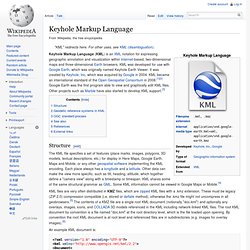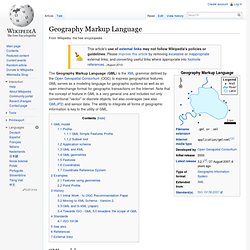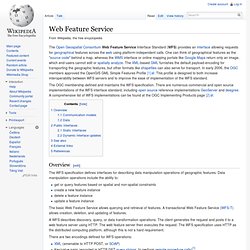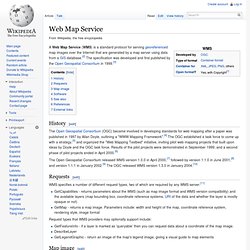

OGC (Open Geospatial Consortium) The Open Geospatial Consortium (OGC), an international voluntary consensus standards organization, originated in 1994.

In the OGC, more than 400 commercial, governmental, nonprofit and research organizations worldwide collaborate in a consensus process encouraging development and implementation of open standards for geospatial content and services, GIS data processing and data sharing. History[edit] A predecessor organization, OGF, the Open GRASS Foundation, started in 1992.[1] From 1994 to 2004 the organization also used the name Open GIS Consortium. The OGC website gives a detailed history of the OGC.[2] Standards[edit] Most of the OGC standards depend on a generalized architecture captured in a set of documents collectively called the Abstract Specification, which describes a basic data model for representing geographic features.
More information here: Relationship between clients/servers and OGC protocols The OGC standards baseline comprises more than 30 standards,[3] including: KML (Keyhole Markup Language) Structure[edit] The KML file specifies a set of features (place marks, images, polygons, 3D models, textual descriptions, etc.) for display in Here Maps, Google Earth, Maps and Mobile, or any other geospatial software implementing the KML encoding.

Each place always has a longitude and a latitude. Other data can make the view more specific, such as tilt, heading, altitude, which together define a "camera view" along with a timestamp or timespan. KML shares some of the same structural grammar as GML. Some KML information cannot be viewed in Google Maps or Mobile.[4] An example KML document is: <? The MIME type associated with KML is application/vnd.google-earth.kml+xml; the MIME type associated with KMZ is application/vnd.google-earth.kmz.
OGC GML (Geography Markup Language) The Geography Markup Language (GML) is the XML grammar defined by the Open Geospatial Consortium (OGC) to express geographical features.

GML serves as a modeling language for geographic systems as well as an open interchange format for geographic transactions on the Internet. Note that the concept of feature in GML is a very general one and includes not only conventional "vector" or discrete objects, but also coverages (see also GMLJP2) and sensor data. The ability to integrate all forms of geographic information is key to the utility of GML. GML model[edit] GML contains a rich set of primitives which are used to build application specific schemas or application languages.
FeatureGeometryCoordinate reference systemTopologyTimeDynamic featureCoverage (including geographic images)Unit of measureDirectionsObservationsMap presentation styling rules Profile[edit] Note that Profiles are distinct from application schemas. GML Simple Features Profile[edit] Subset tool[edit] Application schema[edit]
Web Feature Service. The OGC membership defined and maintains the WFS specification.

There are numerous commercial and open source implementations of the WFS interface standard, including open source reference implementations GeoServer and deegree. A comprehensive list of WFS implementations can be found at the OGC Implementing Products page [2]. OGC WMS (Web Map Service) A Web Map Service (WMS) is a standard protocol for serving georeferenced map images over the Internet that are generated by a map server using data from a GIS database.[2] The specification was developed and first published by the Open Geospatial Consortium in 1999.[3] History[edit] The Open Geospatial Consortium (OGC) became involved in developing standards for web mapping after a paper was published in 1997 by Allan Doyle, outlining a "WWW Mapping Framework".[4] The OGC established a task force to come up with a strategy,[5] and organized the "Web Mapping Testbed" initiative, inviting pilot web mapping projects that built upon ideas by Doyle and the OGC task force.

Results of the pilot projects were demonstrated in September 1999, and a second phase of pilot projects ended in April 2000.[6] Requests[edit] WMS specifies a number of different request types, two of which are required by any WMS server:[11] Request types that WMS providers may optionally support include: Map image[edit] Open Geospatial Consortium.